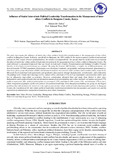Influence of Statist Inter-ethnic Political Leadership Transformation in the Management of Inter-ethnic Conflicts in Bungoma County, Kenya
Abstract
The study interrogates the influence of statist inter-ethnic political leadership transformation in the management of inter-ethnic conflicts in Bungoma County. In Kenya, specifically in Bungoma, the 1963 conflict in the region acquired a political and national outlook. In 1992, despite 29 years of independence, the violence was unparalleled. The specific objective of the study was to examine the effect of statist inter-ethnic political leadership integration in the management of inter-ethnic conflict in Bungoma County. The study followed a conceptual framework that was based on Lederach's Conflict Transformation and Gultang's Conflict Triangle theories. A descriptive research design was adopted. By using the Yamane 1967 formula, a sample size of 400 participants was derived from the 1375065 population. Participants were distributed randomly, purposefully, and proportionately. Questionnaires, interviews, focus group discussions (FGD), and document analysis were used to collect primary and secondary data, respectively. Microsoft Excel performed both quantitative and qualitative data analysis through thematization, corroboration, and verification. The findings were: Unlike inter-marriage (23%), culture (20%), and trade (15%), 42% of respondents concurred that elders were key in influencing inter-ethnic co-existence. However, colonisation alienated them and made them distinct in their roles. Independent statist political leadership transformation mutated from precipitating inter-ethnic inclined: corruption and greed 17%, political repression 16%, political participation in government 15%, punishment 14%, torture 13%, and demotion 12% to inter-ethnic integration of glimpses of diversity policies into political leadership. Even though peacebuilding was going on, the biggest problems that still needed to be solved were the enforcement of inter-ethnic political leadership integration policies in Bungoma County, the translation of the inter-ethnic political leadership transformation initiative into documentary and creative art, and the separation of administrative and political boundaries from ethnic boundaries.
URI
https://doi.org/10.51867/ajernet.4.2.35https://ajernet.net/ojs/index.php/ajernet/article/view/114
http://ir-library.mmust.ac.ke:8080/xmlui/handle/123456789/2295
Collections
- Gold Collection [1021]

